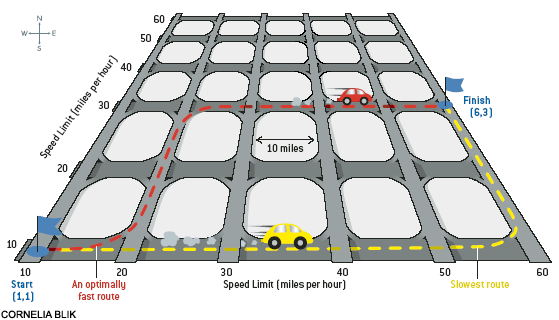Problem D: Grid Speed
Consider a grid in which north-south streets, separated by gaps of 10
miles each, are elevated above east-west streets laid out in a similar
fashion (see illustration for the case of a 6 by 6 grid). All streets
are two-way. Entrance and exit ramps connect the streets at every
intersection. Because there are no traffic lights, switching from a
north-south street to an east-west street, and vice versa, takes
essentially no time. The grid has very little traffic, but the local
police patrol so carefully for speeding that there are virtually no
speeders.

The speed limits follow an unusual pattern. The speed limits are
separately posted for each street and are the same for the entire
street in both directions. In the illustration above, let us label
the intersections using their column and row numbers: the southwestern
corner of the grid is (1, 1), the southeastern corner is
(6, 1), and so on. Part of your task is to determine the
shortest time in which we can get from (1, 1) to (6, 3)
while obeying speed limits.
However, after the Kyoto disagreement, just being fast is not good
enough, one also has to be fuel efficient. Fuel consumption of a car
is given in miles-per-gallon (mpg) and depends on speed of the car.
Speed of a car is given in miles-per-hour (mph) and, in this digital
age, the speed of a car is always a positive integer multiple of 5.
The formula relating mpg to mph is a very simple one: a car travelling
at v mph makes 80-0.03*v2 mpg. In a given
grid of streets we would like to travel from intersection
(xs, ys) to intersection
(xt, yt). You are to
determine the fastest and the most fuel efficient way of making the
trip such that:
- the car does not change speed between intersections,
- the car obeys all speed limits,
- the car travels the shortest possible distance between the start and finish,
and
- the car arrives at the destination in the given time interval.
Input
The first line of input contains an integer t, the number of
scenarios to be processed. The data for each scenario occupy 5 lines.
The first line contains an integer n<=10 which is the
number of horizontal and vertical streets. The second line contains
an integer which is the grid unit size in miles, smaller than 100.
The third and fourth lines contain n integers each,
specifying the speed limits on the horizontal and vertical streets,
respectively. The largest speed limit is 50. The last line of data
for a scenario contains 6 integers. The first four are
xs, ys,
xt, and yt. The last two
integers give the shortest and the longest allowed time to travel in
minutes, inclusive, both not bigger than 1000.
Output
For each scenario, output two or three lines in the format given in
the sample output. If the travel is possible then, on the second line
of output, report the earliest possible arrival time (but within the
imposed limits) and fuel consumed (least possible for this travel
time) and, on the third line, report the earliest arrival time (but
within the imposed limits) that consumes the minimum amount of fuel.
The time is to be reported in minutes (integer), rounded up.
Sample input
3
8
20
10 20 30 40 50 50 50 50
50 50 50 50 50 50 40 50
2 3 7 8 300 320
8
2
10 20 20 30 10 20 10 10
10 20 20 30 10 20 10 20
6 8 2 4 10 39
10
10
30 20 20 10 10 20 10 10 20 20
40 20 10 20 10 20 20 10 10 20
1 1 10 10 100 500
Output for sample input
Scenario 1:
The earliest arrival: 300 minutes, fuel 6.25 gallons
The economical travel: 318 minutes, fuel 5.60 gallons
Scenario 2:
IMPOSSIBLE
Scenario 3:
The earliest arrival: 405 minutes, fuel 4.14 gallons
The economical travel: 498 minutes, fuel 2.76 gallons
Piotr Rudnicki, based on Dennis E. Shasha's column, Scientific
American, March 2004

